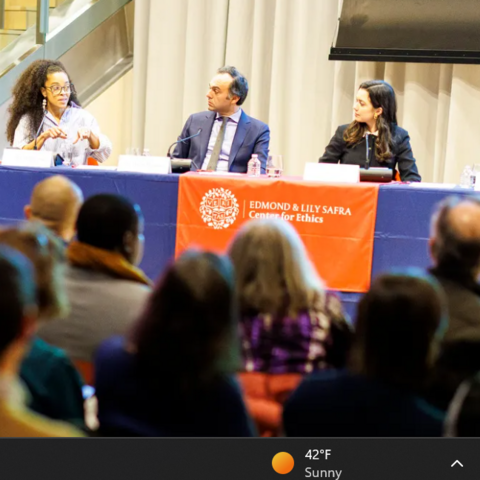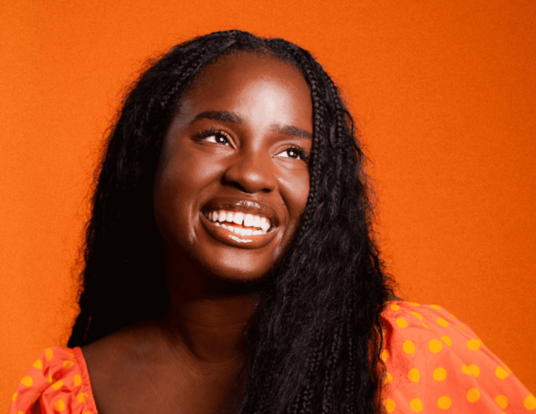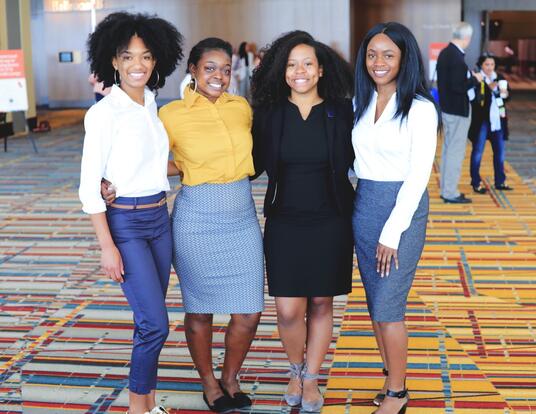The Preciousness of Air
Forging new connections between humans and the environment

Research at Risk: Since World War II, universities have worked with the federal government to create an innovation ecosystem that has yielded life-changing progress. Now much of that work may be halted as funding is withdrawn. Find out more about the threats to medical, engineering, and scientific research, as well as how Harvard is fighting to preserve this work—and the University's core values.
"Air should be something everybody has."
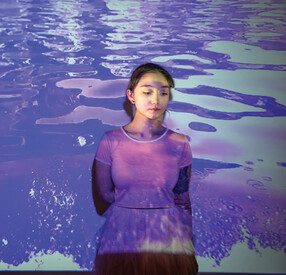
That simple revelation came to Ellie Beaudry when she was in high school in Shanghai. China ranks 137 out of 180 countries on Yale University’s Environmental Performance Index, and according to the Swiss company IQAir, it is the fourteenth most polluted nation in the world. Beaudry, a US citizen whose American father and Chinese mother have lived with her and her younger brother in both countries, says that the international school she went to could afford expensive air purifiers that created “a bubble of clean air around it.” When she got outside, though, she didn’t need a degree in environmental science to know the air was unhealthy.
“I’d go to school on the bus and feel like I was choking on cigarette smoke and ash, and then be in a safe place,” Beaudry recalls. “Local students and even hospitals didn’t have the resources we rich American kids had. I grew up in New Jersey, where no one thinks of air, so it was a mental switch for me. It was something that wasn’t right in the world, and I wanted to help in some way.”
Today, Beaudry, a PhD student in Environmental Science & Engineering, helps in two ways: through her research on ozone pollution in the Atmospheric Chemistry and Modeling Group at the Harvard John A. Paulson School of Engineering and Applied Sciences, and through her professional-level multimedia artwork, which highlights environmental themes. And though at Harvard her attention has necessarily centered on atmospheric chemistry, her art, which has been exhibited internationally, remains a big part of her life—a way to release the pent-up energy and creativity that enliven all she does.
"Good Detective Work"
Particulates such as nitrogen oxide and sulfur dioxide, which are emitted by industry, power plants, and vehicles, have dropped by 40 percent since Beijing declared its “war on pollution” in 2014. But ozone pollution, caused at ground level when volatile organic compounds react with one another and with heat and sunlight, has increased significantly in most large Chinese cities, according to Beaudry’s advisor Daniel Jacob, Vasco McCoy Family Professor of Atmospheric Chemistry and Environmental Engineering at Harvard’s Department of Earth and Planetary Sciences. No one is quite sure why it has gotten worse, but Beaudry’s research may offer some clues.
“Ozone pollution is what will make your eyes burn and your throat hurt,” Jacob says. “In looking for some of the sources of that pollution, Ellie found a lobbying-group report that showed the gasoline produced in China contains methanol, which the air-pollution community didn’t know about. It was pretty creative of her to unearth it. Good detective work.”
“Sometimes you get a lucky break,” Beaudry shrugs. Ethanol additives are promoted for gas over methanol in the United States because they make fuel burn cleaner, she explains, but “East Asia has a very different emission profile.” In the US, most methanol—an oxygenated volatile organic compound, or OVOC—comes from biomass, while in China OVOCs are more likely anthropogenic, or human-made. “There’s a much higher concentration of them there,” Beaudry says. “We’re underestimating them by an order of magnitude, particularly in urban areas.” OVOCs are a precursor to ozone pollution, and because they can have both pollution-forming and pollution-degrading effects, “having a better understanding of them is really important for us to be able to model pollution processes around them and perhaps begin to regulate them.”
Having a better understanding of OVOCs is really important for us to be able to model pollution processes around them and perhaps begin to regulate them.
-Ellie Beaudry
Another largely overlooked source of ozone pollution Beaudry has been studying is VCPs, or volatile chemical products—“the things that smell nice” in household cleaners, beauty products, and perfumes. In cities, she says, more ethanol—which is another source of ozone, even though it reduces emissions overall and boosts engine performance—comes from VCPs than from cars. But “they’re not included in the emissions inventories scientists use to create models,” she says. “Just because a particular compound may have an environmental benefit doesn’t mean we shouldn’t consider the negative effects that might come with using it on a wide scale. It’s always a chain reaction.”
Scientists are researching VCPs in Europe and the US, but Beaudry hasn’t seen any evidence that they’re being studied in Asia and has found no regulations regarding their use. Laws reducing nitrogen oxide and sulfur dioxide—the chemicals released by the burning of fossil fuels—have been helpful worldwide, she says, “but we’re hitting a wall by only targeting those, and we can’t fix the effects of VCPs if we don’t understand the compounds themselves."
New Pathways
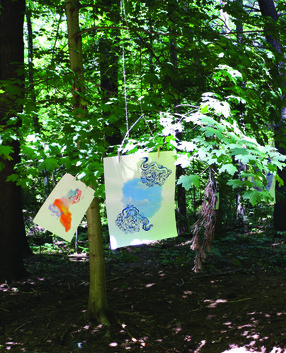
Helping people understand the natural world and the effects humans have on it is one of Beaudry’s goals outside the lab, too. The impulse motivates much of her art, including her most recent installation, the Air Series, a pop-up exhibit she mounted last summer in the Middlesex Fells. The nine oil paintings on paper danced in the breeze, hung by string and clothespins in a copse of trees so that passersby could interact with them. “By hanging the paintings and letting them move with the wind I was trying to get at qualities of air and visualizing the preciousness of it,” she says. “Art in a museum is stagnant and sits there for an eternity, but this could move and change and be inviting.”
The paintings depict clouds in various moods and configurations—including in a yin-yang-shaped sunset and as cottony puffs against a springtime-blue sky—overlaid with line art adapted from Buddhist cave paintings in Dunhuang, China, which for Beaudry resonate with cultural significance. “The East versus West aspect is part of my identity. It’s a way of saying, ‘This is who I am and I belong here and my views should be considered.’”
A lot of young artists repeat what’s been done or what they’ve seen, but she has big, bright, open eyes. [Ellie] knows she’s a global citizen and uses that to make comments about the world.
-Renate Ferro
Beaudry would like to run her own lab someday, but even if she doesn’t go into academia, she says, becoming an expert in atmospheric chemistry is important to enabling her to communicate science through her art. “People are primed to reject research or just ignore it at a time when air pollution and other issues are coming to a head,” she says. “Being able to share this message in a different way is critical to making people aware and maybe being able to bridge the gap.”
Beaudry does installations like the Air Series because she wants to touch people in a way that she can’t in a gallery. “The most important thing is that someone feels something when they see the work,” she says. “And if they feel enough to inquire about it and learn more—if I can spark that curiosity in them—that would be a success. My hope is to encourage engagement and then care.”
Both Daniel Jacob and Peter Hess, a professor in Cornell’s Department of Biological and Environmental Engineering and the director of graduate studies, where Beaudry got a bachelor’s degree in fine arts as well as in environmental engineering, say they’d never seen a student pursue both interests with such intensity. “It’s really quite unusual,” says Hess. “Environmental engineering is very quantitative and art has a different way of seeing the world. But Ellie seems to bring her science mind to her art and vice versa.”
Renate Ferro, Beaudry’s art professor at Cornell and the director of undergraduate studies there, says bringing artistic creativity to science and other fields may seem unconventional today, but it’s the wave of the future. Ferro says Beaudry was one of the students she and her colleagues had in mind when they revamped their department a few years back to be more cross-disciplinary. “In order to envision a more dynamic future, we need to start thinking out of the box,” Ferro says. “Things are moving quickly and students have changed radically in the past few years because of the pandemic and rampant technology. To meet those new demands we need to collaborate and come up with new paradigms.”
Bright Open Eyes
Having more than one focus is nothing new to Beaudry, whose art encompasses painting, drawing, writing, sculpture, stop-motion animation, installations, and digital media. While some of her figurative works draw on the elements of the fantasy and science fiction she grew up reading, many of her videos spotlight a single moving image—water burbling in a creek, for example, or a small fire amid fallen leaves—superimposed with audio that may recount a day in her life in Shanghai, or contemplate the questions of human existence and quantum physics, or tell a poetic tale of the earth’s taste for human sacrifice: Rushing waters are a siren song, the roar of crashing force on jagged rocks a lullaby. They call out to the lost, the lonely, the brash, the overconfident, the ones that are just trying to escape. Have you ever stopped and listened to the falls? Have the whispers followed you home at night? “Come closer, for I am not so cold. Don’t be afraid.”
“She has amazing ideas,” says Ferro, who taught Beaudry when she was a freshman at Cornell and recalls asking her at the time why she wasn’t an art major. By junior year, Beaudry was working toward her dual degree. “She impressed me,” Ferro says, “even though she was competing with seasoned art majors. A lot of young artists repeat what’s been done or what they’ve seen, but she has big, bright, open eyes. She knows she’s a global citizen and uses that to make comments about the world.”
Beaudry hopes that being bilingual and cross-cultural can ease her way toward collaborating with scientists in Asia to do work that “engages with people’s lives rather than just as an intellectual pursuit,” she says. She sees both art and engineering as creative challenges. In science, the challenge is to understand in new ways how the choices we make every day are linked to the air we breathe; in art, it’s to transcend borders and generations through the power of beauty and ideas.
“[Whether in science or art] going from something that’s in your head to reality is never a straight line,” she says. “There are always unforeseen bumps in the road that require creative problem-solving.”
Photos by John Soares; Artwork by Ellie Beaudry
Get the Latest Updates
Join Our Newsletter
Subscribe to Colloquy Podcast
Simplecast


